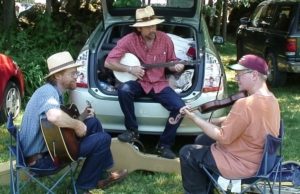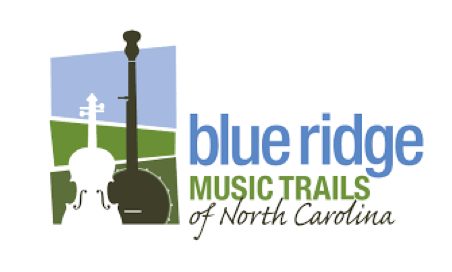Jam Session Etiquette

Mountain music jams can be found throughout the Blue Ridge, at coffeehouses, pubs, stores, festival grounds, and many other venues. Be sure to search our interactive map and events calendar for jam sessions in your area.
Public jams (those held regularly at a particular time and place) and informal, spontaneous jam sessions (that may take place at music festivals) are somewhat different creatures. The customs of each differ, though there are also basic rules of etiquette that apply to both kinds of jams. If you keep these hints in mind, you’ll find that taking part in jam sessions is a great way to learn new tunes and make new friends.
- Public jams are often structured, with designated tune-leaders, an agreed-upon speed (slow for beginners, full-speed for experienced players), and customary ways of beginning and ending tunes. You can ask jam organizers before you go, or when you arrive, what you need to know about that particular gathering.
- Informal jams are usually made up of a group of friends sharing tunes at a festival or other event. Often the musicians will welcome others to join in the playing. Sometimes, though, they prefer to keep their sessions small; for example, they may look like they’re jamming informally when they’re actually practicing for a band contest, or they may be old friends who only have a chance to play together once a year. The best way to find out is simply to ask. Wait until they finish a tune, and ask if they would mind having you join them. (If they invite you to join, you’ll get extra jam session etiquette points for bringing your own chair, or having a snack or drinks to share with the others!)
Whether the jam is formal or spontaneous, here are some important things to remember:
- Some jams are democracies, and others are constitutional monarchies. Observe for a while to figure out how a particular jam is structured. It may be a round-robin, in which each musician takes a turn “calling” (choosing) the tune. Others may be led by one or two individuals who choose all of the tunes. In old-time music this is most often the lead fiddler(s). In bluegrass sessions, which are more likely to emphasize songs over tunes, the leader may be a guitar or mandolin player who is also a skilled lead singer. If there is an elder and especially revered musician taking part, the others will usually defer to him or her, or suggest/request a tune closely associated with that person. Every jam is different, so just take your time to get a feel for what’s going on.
- Be sure you’re in tune with the other musicians. Electronic tuners are a great way to stay on-pitch, but sometimes musicians tune by ear to each other (rather than to standard pitch). Go by how the musicians are tuned first, and rely on your tuner secondarily.
- Be mindful of keys. Old-time jam sessions usually maintain one key for at least a few tunes—and sometimes for hours on end! While a guitarist may be able to switch easily between tunes in G and D, for example, banjo and fiddle players—especially in old-time music—often have to retune their instruments to play in different keys. If you’re not sure what key the group is playing in, or if you have a tune in mind that you’d like to play but aren’t sure what key it’s in, don’t be afraid to ask.
- Do your best to keep in time with the other musicians. If you lose your place in a tune, just hang back and play quietly until you find your place again.
- If you don’t know a tune, play quietly until you get the hang of it. It’s better to play quietly until you know how it goes than to play loudly while you’re figuring it out! Once you know how the tune goes, play at a volume like that of the other musicians, but without overpowering them. If you are leading a tune, it’s customary to play a little bit louder than the others, so that they can follow you.
- Bluegrass musicians “take breaks,” which means that each individual plays his or her own improvised lead for a few bars of the tune. Whoever is leading the song will usually indicate whose turn it is to take a break.
- Old-time musicians do not take breaks, but all play a tune in unison throughout. This doesn’t mean that you can’t improvise. Subtle improvisation is an important part of old-time playing, but it’s done within the context of everyone playing together, rather than in bluegrass-style solos.
- The person who starts/leads a tune is also responsible for ending it. There are many ways to signal to the other musicians that you’re ready for the piece to end. You can raise one foot in the air as you get towards the end, or you can call out something like “one more,” “last time,” or “going out.” Musicians who have played together before often understand each other’s cues without needing overt signals. In those sessions, listen out for a brief but momentary pause between notes, a change in volume or tempo, or quick exchanges of eye contact or nods.
- Resist the urge to “noodle” on your instrument between tunes. Musicians in a jam often use the break time to comment on the last tune and discuss possibilities for the next one, so any noodling can be an annoying distraction. You can join in the discussion, say hello to your neighbor, or check your tuning quietly.
- Most importantly, enjoy yourself! Remember that playing in a jam session is not like being on stage. It’s more about socializing than performing. It’s okay to learn as you go along, to make mistakes, to ask questions. Most mountain musicians welcome fellow enthusiasts, and will enjoy meeting and sharing music with you.
Visit the Down The Road on the Blue Ridge Music Trails Podcast Library to hear more about the tradition of jam sessions and explore many bluegrass and old-time music stories, performers, and traditions across the mountain and foothills counties of Western North Carolina.





